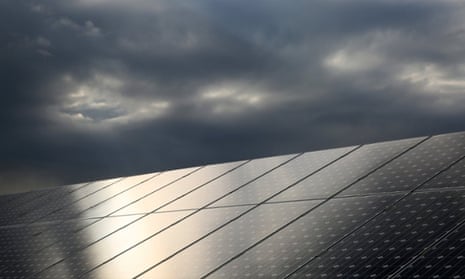Almost 89% of Australians want the renewable energy target increased or kept the same, according to new polling designed to shore up Senate opposition to plans by the government and some crossbench senators to wind back the policy.
The polling found support for the policy – which requires that 41,000 gigawatt hours of electricity be sourced from renewables in 2020 – was even higher in Victoria, South Australia and Tasmania, the home states of crossbench senators Ricky Muir, Nick Xenophon and Jacqui Lambie who hold deciding votes on any attempt to push RET change through the Senate.
Commissioned by WWF, the Reachtel polling found a strong majority of voters in the three states thought it was “very important” for the federal government to invest in renewable energy (60% in South Australia and 62.4% in Victoria and Tasmania, compared with 59.8% nationally).
Talks between the Abbott government and the Labor opposition to find a bipartisan agreement on the RET have broken down and a “compromise” plan circulated by Liberal Democrat senator David Leyonhjelm is understood not to have the support of senators Bob Day, John Madigan and Jacqui Lambie.
The government had originally signalled it wanted very deep cuts to the target – and commissioned the businessman and self-professed climate sceptic Dick Warburton to undertake a review, which recommended it be slashed to about 16,000 gigawatt hours.
But after fierce resistance from industry and concerted criticism of that review, the federal cabinet asked Hunt and Macfarlane to try to reach a bipartisan agreement about the future of the program that would allow continued investment without fear of policy change.
Labor walked out of the talks earlier this month, with the Labor leader, Bill Shorten, insisting “there is no point in leading people up the garden path” or having negotiations with people who didn’t want to negotiate. Labor rejected a bid by the government to reopen talks last week because the Coalition was not offering any concessions.
The major parties had agreed aluminium smelting should be exempted from the RET – and that industry has been lobbying to break the political impasse, as has the renewable industry.
The poll found very high support for the RET among swing voters – those considering changing their voting preference from 2013. Some 88% of those voters think the RET should be increased or stay the same and 64% of those considering a change in vote supported an increase to the RET, with only 12% supporting a decrease. And 62% were more likely to vote for a party that supports keeping or increasing the current RET.
“Cutting the RET makes no sense. It will see Australia’s carbon pollution go up, sustainable energy jobs lost and investment shut out. It’s also out of line with public sentiment which is clearly in favour of supporting growth in Australia’s renewable energy sector, including wind and solar,” said WWF spokeswoman Kellie Caught.
Polling has repeatedly found very strong voter support for renewables. Another recent poll by the Australia Institute found 64% of self-identified Liberal voters supported an increased target.
But the current impasse has seen investment dry up, and if it is not resolved, electricity retailers will run out of new renewable energy to buy to meet their legislated requirements – forcing them to pay a “penalty” price.
The Reachtel poll, conducted on 26 November, contacted 5,036 voters around Australia, including 1216 in Victoria, 934 in Tasmania and 873 in South Australia.

Comments (…)
Sign in or create your Guardian account to join the discussion